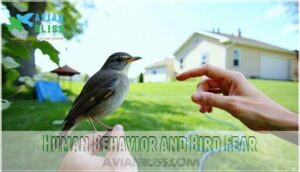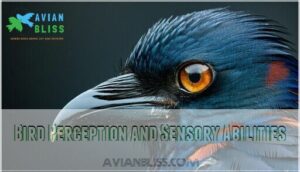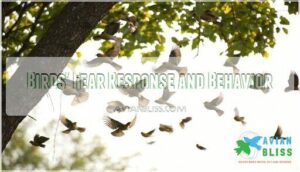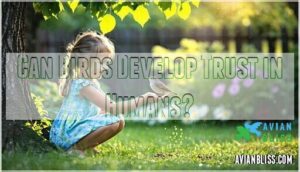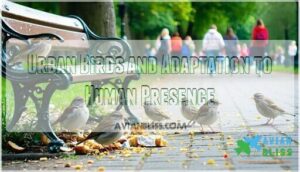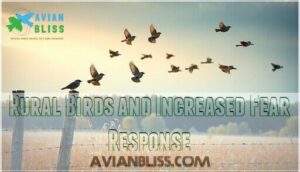This site is supported by our readers. We may earn a commission, at no cost to you, if you purchase through links.
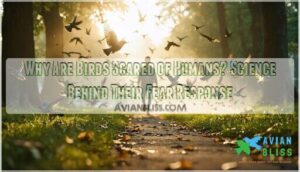
Research shows that fear of humans gets passed down through bird genes—somewhere between 37% and 80% of that wariness is inherited. Birds can see twice as clearly as you, spotting potential danger from 50 meters out. Your size alone sets off their internal alarms.
When you move suddenly, their brain reads it as an attack coming, and they bolt.
Urban birds tolerate closer approaches than rural counterparts, but the underlying fear mechanism remains. Understanding what triggers their flight response reveals fascinating insights about perception, adaptation, and coexistence.
Table Of Contents
- Key Takeaways
- Birds’ Instinctual Fear of Humans
- Human Behavior and Bird Fear
- Bird Species and Individual Differences
- Bird Perception and Sensory Abilities
- Birds’ Fear Response and Behavior
- Can Birds Develop Trust in Humans?
- Urban Vs. Rural Bird Behavior
- Lessons From Birds’ Fear of Humans
- Fostering a Harmonious Relationship
- Frequently Asked Questions (FAQs)
- Are birds naturally scared of humans?
- Why do birds fly away from people?
- Why are birds so scared of me?
- Why do birds fly away when I look at them?
- Do birds recognize individual humans or just humans in general?
- Can birds be scared of humans without prior interactions?
- Do birds fear responses to humans change with age?
- Can birds fear of humans be influenced by other birds?
- Are birds more scared of humans in certain weather conditions?
- How do birds communicate danger to their flock?
- Conclusion
Key Takeaways
- Birds’ fear of humans stems from genetic programming shaped by millions of years of predation pressure, with heritability estimates ranging from 0.37 to 0.80, meaning wariness is literally encoded in their DNA and reinforced through survival advantages across generations. – Your physical presence—size, sudden movements, and unpredictable behavior—triggers instinctive escape responses because birds’ visual acuity (up to twice as sharp as human vision) detects perceived threats from over 50 meters away, making even casual approaches register as predatory strikes. – Urban birds demonstrate that fear responses can be modified through consistent, non-threatening exposure, showing up to 34% shorter flight distances compared to rural populations, which proves adaptation is possible when human behavior becomes predictable and safe. – The evolutionary trade-off between vigilance and survival means heightened fear protects birds from threats but comes at the cost of reduced feeding time and energy reserves, explaining why they’ll flee even when you pose no actual danger.
Birds’ Instinctual Fear of Humans
Birds don’t trust humans—and for good reason. Evolution taught them we’re dangerous. Our size alone screams predator, and the way we move doesn’t help.
Bad experiences get passed down through bird communities, and you’ve got generations of wariness baked right in.
Evolutionary Development of Fear
Regarding why birds fear humans, evolutionary instinct holds the answer. Predation pressure over millions of years has shaped birds’ instinctual fear, with genetic heritability estimates ranging from 0.37 to 0.80 depending on species and environment. Birds that maintained wariness survived to pass these traits forward, making fear an adaptive legacy reinforced by maternal influence and behavioral trade-offs between vigilance and foraging efficiency. The Red Junglefowl study demonstrated a significant genetic component in fear responses. Red Junglefowl study demonstrated a significant genetic component in fear responses to humans.
Evolution shaped bird fear through simple math: the cautious ones lived long enough to breed.
- Flight distance varies by species and setting – larger birds escape earlier, while urban populations show reduced wariness compared to rural counterparts
- Genetics and early experience combine – mothers with high fearfulness raise more cautious offspring, amplifying inherited fear responses
- Survival comes at a cost – heightened alertness protects against threats but reduces feeding time and energy reserves
Human Size and Movement as Threats
While evolution wired birds to be wary, your physical presence amplifies that ancient alarm—think about it from a sparrow’s perspective, where even a casual human stroll looks like a predator closing in. Your sheer size registers as a perceived threat, triggering flight initiation before you’re even aware you’ve been noticed.
Birds spot you from far away—their sharp eyes pick up movement long before you realize they’re watching. When you move unpredictably, their threat radar goes into overdrive.
- Looming stature – Your height creates a predatory silhouette that signals potential threat.
- Sudden approaches – Quick movements activate instinctive escape responses.
- Erratic paths – Unpredictable motion heightens unfamiliarity and unpredictability of humans.
- Rapid gestures – Swift arm or leg movements mimic predatory strikes.
Past Negative Experiences and Learning
Beyond size and movement, your past actions—or those of humans before you—leave lasting impressions that shape how birds react when you approach. Trauma inheritance means aversive conditioning from trapping or interaction effects passes through social learning, creating learned avoidance that persists across generations.
Rescue birds often display heightened wariness, illustrating how historical context and learned behavior increase perceived threat responses. This unfamiliarity and unpredictability of humans becomes deeply embedded, influencing factors that govern birds’ fear long after the original incident.
Human Behavior and Bird Fear
You mightn’t realize it, but your everyday actions—how you move, the sounds you make, even your scent—can set off alarm bells in a bird’s brain.
So what exactly are those triggers? Here are the specific human behaviors that spark their fear response.
Unpredictable Movements and Noises
You don’t need to wave your arms or shout to scare a bird—even your smallest, most casual movements can set off alarm bells in their finely tuned nervous systems. Birds evolved with predators, so unpredictable behavior triggers an immediate startle response. Quick gestures, loud sounds, and erratic paths all signal danger, prompting flight initiation. Even noise pollution from traffic disrupts their communication and heightens anxiety.
A few things consistently trigger that startle response:
- Sudden actions like reaching toward them or changing direction unexpectedly
- Loud sounds that mimic threats or interfere with their alarm calls
- Unpredictable human presence that prevents them from anticipating your next move
Body Language and Facial Expressions
Birds read your posture, gestures, and even the direction of your gaze with striking precision, often deciding whether to flee before you’ve taken a single step. Direct eye contact signals predatory intent, while sudden changes in posture activate their fear response. They interpret your body language through contextual interpretation, combining visual cues with vocal cues from your environment. Even feather positioning on nearby birds can heighten their alarm if your movements seem threatening during human interaction.
To seem less threatening, try these approaches:
- Avoid prolonged eye contact – sideways glances feel less predatory
- Keep your body low and angled – direct frontal approaches trigger flight
- Move slowly with predictable patterns – abrupt gestures read as attacks
- Relax your shoulders and arms – tense posture signals stress they’ll mirror
Impact of Human Scent and Sounds
Though birds lack the keen sense of smell found in mammals, the soundscape you create—from rustling fabric to casual conversation—reaches their ears with far greater clarity than you might expect. Noise pollution effects disrupt their communication calls, while auditory masking prevents them from detecting predators.
Chemical signals from your skin matter less than the sensory disruption caused by environmental stressors like car alarms or construction. Your footsteps alone can trigger scent-triggered fear responses in ground-nesting species, where sensory abilities evolved to detect vibrations and sound patterns that signal danger.
Bird Species and Individual Differences
Not all birds react to humans the same way. Let’s look at how species differences, individual temperaments, and exposure to people shape each bird’s fear response.
Variations in Fear Response Among Species
Different avian species display striking variation in how they react to your presence. Flight initiation distance—the point at which a bird takes off—ranges from about 2 to 20 meters across 81 studied species, revealing dramatic interspecific variation shaped by evolutionary factors and ecological context.
Several factors drive these patterns:
- Body size matters: Larger birds generally flee earlier, sensing you as a bigger threat from farther away
- Flock size amplifies caution: Birds in larger groups often react sooner due to collective vigilance
- Urban adaptation shifts behavior: City-dwelling species tolerate closer approaches than their rural counterparts
- Waterbirds show functional differences: Waders and gulls let you get closer than mergansers do
- Life history shapes response: Diet, migratory patterns, and breeding systems all influence species-specific wariness
Understanding these variations in bird behavior helps you recognize why some species seem bolder while others vanish at your slightest movement. The size of the conspecific flock greatly influences escape decisions.
Individual Bird Personalities and Experiences
Just as no two siblings respond identically to a stranger at the door, individual birds carry their own behavioral fingerprints shaped by genetics and life experience. Personal fear thresholds vary widely—some individuals tolerate close approaches while others flee at distant movement.
Trauma and fear from past negative encounters create learned fear patterns, though bird resilience allows habituation when you consistently demonstrate gentle behavior.
These personality variations mean individual learning curves differ, with bolder birds adapting faster to your presence than cautious ones.
Adaptation to Human Presence
When you spend time around both city parks and remote forests, you’ll quickly spot a striking pattern—birds in each setting treat your presence like two entirely different events. Urban bird adaptation reshapes fear thresholds dramatically, with city birds tolerating closer approaches than their rural counterparts. This human habituation reflects exposure frequency rather than genetic shifts:
- Urban wildlife often views you as a food source rather than threat
- Noise adaptation allows city birds to function amid constant human activity
- Tolerance thresholds shrink in urban environments, where birds accept 10-foot distances versus 100-foot buffer zones rurally
- Urban bird taming progresses fastest when you provide consistent, non-threatening interactions
Urban vs rural bird behavior showcases evolutionary flexibility responding to environmental pressure.
Bird Perception and Sensory Abilities
Birds don’t miss much—they’ve got sharp eyes and keen ears that pick up on threats long before you realize you’re being watched.
Let’s look at how their sensory toolkit shapes the way they perceive and react to human presence.
Excellent Vision and Environmental Awareness
If you’ve ever wondered why birds seem to notice you before you notice them, it’s because their visual acuity can reach up to two times sharper than yours. Their eyes, packed with up to a million cone cells per square millimeter, allow them to detect predators, navigate complex environments, and assess potential threats from hundreds of meters away. This striking color perception extends into ultraviolet wavelengths, revealing environmental cues invisible to humans and shaping birds’ fear response to environmental stressors.
Their sensory abilities shape threat perception in three key ways:
- Predator detection: You’re spotted long before you’re close, triggering behavioral adaptations like early flight.
- Environmental tracking: They assess weather, light, and habitat quality with precision.
- Distance assessment: Flight initiation often exceeds 50 meters in open areas.
Sensitivity to Human Scent and Sounds
While your eyes might be a bird’s first alarm system, your scent and the sounds you make create a secondary wave of information that shapes whether they’ll stay or fly. Birds rely on auditory sensitivity to interpret your presence, detecting frequencies and patterns that signal danger. Noise pollution disrupts their communication and triggers sound-induced stress, elevating their fear response. Though most birds don’t depend heavily on olfactory detection, human scent still registers as unfamiliar.
These sensory inputs trigger specific reactions:
| Sensory Input | Bird Response | Environmental Factor |
|---|---|---|
| Loud, sudden sounds | Flight initiation within seconds | Urban noise pollution |
| Unfamiliar human scent | Increased vigilance | Proximity to human activity |
| Repetitive noise patterns | Stress hormone elevation | Traffic and machinery |
| Quiet, predictable sounds | Reduced fear response | Natural soundscapes |
| Chemical signals | Avoidance behavior | Impact of human scent on nesting sites |
Triggering Fear Responses
Once these sensory signals reach a bird’s brain, they don’t just register as information—they ignite an instant, instinctual cascade that determines whether the bird will freeze, flee, or fight.
What sets off this fear response? A few key things:
- Sudden movements activate their motion-detection systems, signaling a potential threat
- Loud noises create sensory overload, overwhelming their auditory processing
- Unpredictable human interactions that lack pattern or rhythm
- Perceived threats from size, approach speed, or direct eye contact
These bird fear response mechanisms evolved to prioritize survival over curiosity.
Birds’ Fear Response and Behavior
When a bird senses danger, its response kicks in fast—whether that means taking flight, standing its ground, or sending out warning signals.
Let’s look at how birds react when they feel threatened and what these behaviors reveal about their survival instincts.
Flight Response and Prioritizing Safety
If you’ve ever watched a bird burst into the air at your approach, you’re witnessing one of nature’s most finely tuned survival mechanisms in action. This flight response represents an instant risk assessment, where your bird friend calculates that escape beats staying put. Birds rely on their survival instincts to trigger evasive maneuvers the moment they perceive danger, launching into predator avoidance mode without a second thought. It’s not personal—they’re hardwired to prioritize safety over curiosity.
This fear response works so well because of three key factors:
- Split-second decisions: Birds assess threats in milliseconds, evaluating your distance, speed, and trajectory before executing their escape mechanisms.
- Energy trade-offs: Flight burns calories, so birds constantly weigh the cost of fleeing against the risk of staying, refining their survival strategies through experience.
- Zone of tolerance: Each species maintains a specific "flight initiation distance"—get closer than that invisible boundary, and instinct takes over.
Fight Behaviors and Defensive Strategies
Not every bird opts for the exit when you get too close—some stand their ground and fight back with surprising ferocity. Crows gang up on hawks through mobbing behavior, dive-bombing and harassing until the threat retreats. Some species employ predator mimicry, puffing up feathers or hissing like snakes to appear more dangerous than they are.
Defensive vocalizations—sharp alarm calls—rally nearby birds into cooperative defense, turning a single target into a coordinated assault. These aggressive displays, from wing-spreading to beak-snapping, reflect the fight half of the fight-or-flight response.
Birds weigh survival instincts against energy costs, choosing confrontation when flight isn’t the smarter play for predator avoidance.
Communication of Fear Through Body Language
Birds don’t just flee—they telegraph their unease through a silent language of feathers, posture, and quick, jerky movements that broadcast danger long before they take off. You’ll spot sleeked plumage pressed tight against the body, a crouched stance ready to launch, and rapid head-swiveling as they track your position.
Alarm calls pierce the air, recruiting nearby birds into heightened vigilance, while tail flicks and wing-twitching reveal mounting anxiety that precedes avoidance behavior.
Can Birds Develop Trust in Humans?
Yes, birds can learn to trust humans, though it takes time and the right approach.
The key lies in consistent, gentle interactions that gradually shift their perception from threat to neutral presence.
Habituation and Repeated Non-Threatening Interactions
Think of habituation like learning to ignore the hum of a refrigerator—birds can tune out threats that prove harmless over time, turning their initial alarm into acceptance. Through consistent interactions and gradual exposure, you’re teaching birds that you’re not a predator. This learned behavior builds bird trust through positive reinforcement, where each safe feeding encounter strengthens their comfort with human interaction.
Once birds see you as part of their environment rather than a threat, you can use a few simple techniques to deepen that connection:
- Move predictably around feeders, keeping your motions slow and deliberate
- Maintain consistent routines so birds anticipate your presence without alarm
- Speak softly or hum quietly, establishing auditory familiarity
- Respect their flight distance, gradually decreasing it over weeks or months
Positive Experiences and Gentle Behavior
When you approach birds with patience and a pocket full of seeds, you’re not just offering food—you’re extending an invitation to rewrite their inherited wariness into something closer to partnership.
Gentle interactions with birds create positive reinforcement loops that reduce bird stress. Position feeders in calm spots, move deliberately, and speak softly—these safe feeding practices help birds associate your presence with security rather than danger, earning their trust one seed at a time.
Building Trust Through Predictable Movements
Consistency is the secret handshake that opens the door to a bird’s guarded world. When you establish consistent routines—visiting at the same hour, moving with gentle movements and slow approaches—birds begin recognizing patterns rather than threats.
Your quiet presence and calm demeanor transform human interaction with birds from unpredictable danger into reliable safety.
Understanding bird behavior reveals that positive interactions with birds depend on predictability: building trust with birds means becoming part of their landscape through steady, non-threatening behavior that takes into account key factors contributing to fear.
Urban Vs. Rural Bird Behavior
Where a bird lives shapes how it reacts to you. Urban and rural environments create strikingly different patterns in avian fear responses, influenced by exposure frequency, habitat structure, and the predictability of human behavior.
Urban Birds and Adaptation to Human Presence
You’ve probably noticed that city birds act like they own the sidewalk. Urban tolerance has reshaped bird behavior in measurable ways—flight initiation distances drop by up to 34% compared to rural populations. Habituation speed matters, too; urban house sparrows reduce startle responses far faster than their country cousins.
This adaptation goes deeper than just nerves. Dietary breadth expands as birds swap insects for pizza crusts, while reduced aggression and bigger clutches help them thrive despite the chaos. The downside? Functional homogenization means bold generalists dominate while specialists vanish.
Urban versus rural—the comparison tells the whole story:
Trait Urban Birds Rural Birds
Repeated non-threatening human interaction builds this tolerance. Birds in parks with regular feeding show 40% shorter escape distances, proving that predictable human presence reshapes how birds assess risk in the urban environment.
Rural Birds and Increased Fear Response
Step into the countryside, and you’ll find birds treating you like a grizzly at a bird feeder—fleeing before you’re even close. Rural birds maintain heightened fear responses due to limited human interaction and persistent predator threats. Habitat loss and nest predation from introduced species like rats intensify their wariness, while island colonization historically taught birds that human presence means danger. Studies show rural populations exhibit elevated corticosterone levels compared to urban counterparts, reflecting chronic stress from unpredictable human impact on bird behavior.
| Factor | Impact on Rural Birds |
|---|---|
| Human interaction | Minimal exposure increases fear responses |
| Predator introduction | Rats, foxes increase nest predation rates |
| Habitat fragmentation | Reduces safe zones, amplifies stress |
| Corticosterone levels | Higher baseline stress hormones detected |
| Flight initiation distance | 34% longer than urban avian behavior |
Environmental Influence on Bird Behavior
Your surroundings—whether you’re in a concrete jungle or wide-open farmland—directly influence how birds react to your presence. Urban environments foster adaptation through repeated, non-threatening human encounters, reducing flight distances. Meanwhile, Habitat Fragmentation and Noise Pollution from Human Encroachment create chronic stress in rural populations. Climate Change shifts food availability, while Light Pollution disrupts migration patterns. These Environmental influences reshape avian responses, as shown below:
| Environmental Factor | Urban Impact | Rural Impact |
|---|---|---|
| Habitat disturbance | Moderate; birds adapt to human activities | Severe; fragmentation increases stress |
| Noise Pollution | High exposure; birds adjust calls | Low but startling; triggers flight |
| Human impact on bird behavior | Habituation reduces fear response | Minimal contact amplifies wariness |
| Light Pollution | Constant; alters nocturnal behavior | Rare; preserves natural rhythms |
| Climate Change | Heat islands affect nesting | Weather extremes threaten survival |
Lessons From Birds’ Fear of Humans
Understanding why birds fear us opens the door to smarter, kinder interactions. Here’s how you can apply these insights to foster a more respectful relationship with the birds around you.
Respectful Behavior and Reduced Noise
Once you understand how your presence affects birds, you’ll find that simple adjustments to your behavior can transform tense encounters into peaceful coexistence. Responsible birdwatching practices revolve around creating a calm environment where birds feel safe. A quiet approach matters—birds detect vibrations and sudden sounds that spike their stress hormones, triggering immediate flight responses.
You can cut down on disturbance by making a few simple adjustments:
- Speak in soft voices or whisper when near nesting sites
- Move with gentle gestures, avoiding rapid arm movements
- Reduce the impact of human sounds by turning off radios and silencing phones
- Maintain at least 10-15 feet from feeding or roosting birds
- Approach from predictable angles rather than darting unpredictably
These bird-friendly adjustments honor their evolutionary wariness while fostering peaceful coexistence in shared spaces.
Bird-Friendly Actions and Creating a Safe Environment
Beyond simply being quiet and still, you can take active steps to reshape your yard or balcony into a refuge where birds thrive rather than just tolerate your presence. Habitat restoration through sustainable landscaping transforms stressed environments into bird sanctuaries.
Responsible birdwatching practices extend to creating bird-friendly environments year-round:
- Plant native species that provide natural food sources and nesting sites, supporting wildlife conservation.
- Install window deterrents like decals or screens to prevent collisions in your safe environment.
- Keep cats indoors to reduce predation, honoring birds’ fear response mechanisms through eco-friendly practices.
Understanding Bird Behavior and Needs
The real magic happens when you start reading the landscape through a bird’s eyes—noticing what triggers fear, what invites curiosity, and how each species navigates the world differently.
Understanding bird behavior means recognizing flight patterns during migration, observing nesting behaviors in spring, and learning which native plants sustain avian nutrition.
You’ll notice how habitat preservation reduces bird anxiety, while studying their fear response mechanisms—from alarm calls to escape routes—reveals the instinctual fear driving their daily survival decisions.
Fostering a Harmonious Relationship
Understanding why birds fear us is just the beginning—now it’s time to explore how you can bridge that gap.
Here are practical ways to create a world where both you and your feathered neighbors can thrive together.
Respecting Birds’ Space and Boundaries
If you’ve ever watched a bird flutter away the moment you stepped outside, you know that earning their trust starts with giving them room to breathe. Maintain a respectful distance during observations, keeping movements slow and predictable. Avoid touching birds, even those that appear comfortable with human presence.
In your yard, position feeders and water sources away from high-traffic areas, creating bird-friendly zones where avian visitors feel secure. This personal space awareness reduces stress and aids bird conservation in urban environments.
Creating a Bird-Friendly World Through Simple Actions
Small changes in your daily routine can ripple outward, transforming your backyard into a sanctuary where birds feel safe enough to linger. You’re building more than a feeding station—you’re creating bird-friendly environments that foster wildlife preservation and sustainable living.
Here’s what you can do:
- Install native feeders and water sources positioned away from windows to prevent collisions while fostering bird conservation.
- Plant native vegetation that offers natural food and shelter, turning green spaces into functional ecosystems.
- Minimize outdoor cat access to protect vulnerable species and maintain a safe environment.
- Reduce pesticide use to preserve the insects birds depend on, strengthening eco-conservation efforts in your neighborhood.
These simple actions transform ordinary yards into bird sanctuaries where trust can flourish.
Encouraging Coexistence With Humans
Transforming our neighborhoods into places where humans and birds thrive side by side doesn’t require grand gestures—just thoughtful awareness of how your presence shapes their world.
Start by knowing your local birds—how close is too close? Every species has its own comfort zone, and learning those flight distances means you’ll know when to give them space during everyday encounters.
Urban planning that incorporates green corridors and native plantings promotes bird conservation while creating wildlife harmony in cityscapes.
Earning birds’ trust means moving predictably, keeping noise down, and designing bird-friendly environments where they feel secure enough to stay.
Frequently Asked Questions (FAQs)
Are birds naturally scared of humans?
Birds fear humans, yes—not out of spite, but survival. Their instinctual fear stems from evolutionary instinct, where human presence signals danger.
Our size, unpredictable movements, and past encounters trigger natural defenses shaped by bird psychology and species variations.
Why do birds fly away from people?
Like watching a deer bolt at a snapped twig, birds take flight when you approach—not from malice, but because their survival depends on it.
Birds flee when you approach because their survival depends on it—not from malice, but from millions of years of evolution teaching them caution saves lives
Your size, sudden movements, and unpredictable path trigger their hardwired fear response.
Flight patterns prioritize safety over curiosity, as human proximity signals potential danger birds can’t afford to ignore.
Why are birds so scared of me?
When you walk toward a bird, you’re triggering instinctual fear rooted in millions of years of survival.
Bird fear response to human presence isn’t personal—it’s learned behavior and fear conditioning shaped by species traits, urban habitats, and bird socialization experiences that reinforce your unpredictability as a potential threat.
Why do birds fly away when I look at them?
Notice how birds scatter the moment your gaze meets theirs? Direct eye contact triggers their instinctual fear because predatory instincts use focused staring before attacking.
Your eye contact signals a perceived threat, activating their flight response through bird fear response mechanisms evolved over millennia to guarantee survival.
Do birds recognize individual humans or just humans in general?
Certain species, like crows and pigeons, recognize individual humans through facial features and learned behavior, not just humans in general. Bird recognition abilities vary by species—corvids excel at distinguishing between people based on past interactions, whether positive or negative.
Through social learning and repeated human contact, individual birds develop unique responses to specific people, forming individual trust with those who consistently demonstrate gentle behavior. These bird personalities and cognitive abilities allow them to distinguish friend from foe, shaping bird behavior around humans in remarkably nuanced ways.
Species variance means urban-adapted birds often show stronger recognition than their rural counterparts.
Can birds be scared of humans without prior interactions?
Everyone knows fear spreads like wildfire—but what if it’s already built into your DNA? Yes, birds can fear humans without any prior contact.
Their innate fear response and genetic predisposition trigger instinctual reactions to perceived threats like your size and movement, activating their fight-or-flight response as a survival mechanism shaped by environmental cues.
Do birds fear responses to humans change with age?
Young birds start out bold and curious, but their fear response shifts as they mature. Through repeated encounters and learned behavior from adult flock members, juvenile bird behavior evolves during the maturation process—aging birds become increasingly cautious.
This fear development reflects accumulated experience, stress responses, and individual bird personalities shaped over time.
Can birds fear of humans be influenced by other birds?
Observing others shapes avoidance—this form of social learning means birds adopt fear responses by watching flock members react to humans.
Your presence might alarm an entire group if one bird signals danger, demonstrating how collective anxiety spreads through bird communication and influences learned behavior across different bird species with varying personalities.
Are birds more scared of humans in certain weather conditions?
During storms and extreme temperature swings, your fear responses sharpen—and birds do the same. Weather patterns intensify stress responses, making avian behavior more cautious around human presence.
Storm anxiety, humidity influence, and climate effects all heighten environmental influences on their survival instincts.
How do birds communicate danger to their flock?
When danger looms, birds don’t panic in silence—they sound the alarm. Sharp alarm calls pierce the air, instantly warning their flock. They also employ visual signals, such as wing flashes and tail flicks, to communicate threats.
Mobbing behavior takes center stage when multiple birds unite to harass predators. This coordinated effort sometimes involves mimicry tactics to confuse threats while maintaining flock cohesion through synchronized responses.
Conclusion
Ironically, understanding why birds are scared of humans makes coexistence easier, not harder. Their fear isn’t personal—it’s evolutionary software running on genetic hardware.
Urban birds show us adaptation is possible when we move predictably and respect flight distances. By recognizing that size, sudden movements, and unpredictable behavior trigger their ancient alarm systems, you can minimize disturbance.
Their wariness kept their ancestors alive; your awareness keeps both species thriving in shared spaces today.
- https://www.geographyrealm.com/human-driven-extinction-birds/
- https://www.scienceofbirds.com/blog/top-5-global-threats-to-bird-populations
- https://pmc.ncbi.nlm.nih.gov/articles/PMC12025121/
- https://blumsteinlab.eeb.ucla.edu/wp-content/uploads/sites/104/2022/06/Morelli_etal_2022_SOTE.pdf
- https://estebanfj.bio.purdue.edu/papers/JFishWildlifeManagement7.pdf

